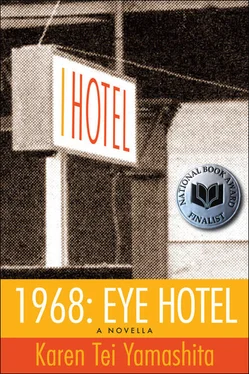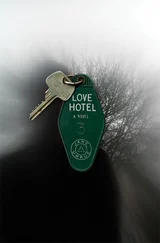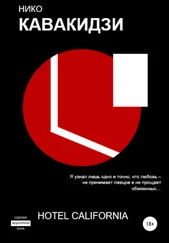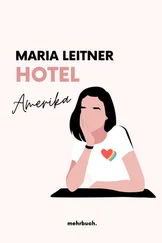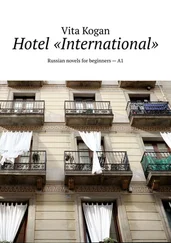(Men argue in Chinese with the following subtitles)
Why don’t you tell TV what they want to hear? Like we got an underground tunnel system. Connects gambling joints to opium dens to prostitution houses. All run by the Hock Sair Woey!
Tell them you’re a fucking spy for Doctor No!
Draw them a map of the tunnels! Secret door right here underneath us. Push a button. Bingo! They can send their luk yi down there to die!
SOUNDS of laughter and continuing monologue of Crazy Man.
10 CLOSE—RICE PAPER
A hand with a flat piece of charcoal is rapidly working over the surface of rice paper tacked up on a wall. Very slowly the charcoal reveals carved Chinese characters beneath the paper. SOUND of charcoal against paper.
VOICES
(reading in Chinese overlaid by English translation)
Instead of remaining a citizen of China, I willingly became an ox.
I intended to come to America to earn a living.
The Western-styled buildings are lofty, but I have not the luck to live in them.
How was anyone to know that my dwelling place would be a prison?
11 EDMUND LEE
A young expert and translator of Chinese literature, Edmund Lee, is interviewed.
EDMUND LEE
This poem is one of more than one hundred poems inscribed by Chinese immigrants on the walls of the Angel Island barracks over a period of thirty years, from 1910 to 1940.
12 CUT TO—ANGEL ISLAND HISTORY
Photo stills of Angel Island history and Chinese detention.
EDMUND LEE
(voice-over) One hundred and seventy-five thousand Chinese immigrants passed through Angel Island, also known as the Ellis Island of the Pacific.
Immigrants were detained for medical examination, interrogation of documents, and deportation. They lived imprisoned in these barracks for months and years. Some made the long journey across the ocean never to touch the mainland.
Chinese laborers were excluded from immigration by a long history of U.S. laws beginning with the Chinese Exclusion Act of 1882. Chinese could, however, enter as merchants or as the descendants of American citizens.
13 PAUL LIN—POET IMMIGRANT
A young Chinese American poet, Paul Wallace Lin, muses about the poets and their poems.
PAUL LIN
(points to the charcoal impression of the poem he’s removed from the wall)
I imagine this poet was a “paper son,” bought his immigration papers from a Chinese “paper father” he never knew.
14 PHOTO STILLS—SAN FRANCISCO EARTHQUAKE
PAUL LIN
His paper father was in San Francisco at the time of the Great Earthquake in 1906. When the city records were destroyed by fire, he got himself an American birth certificate, sailed home to China, and recorded the birth of ten sons—ten paper sons who could be citizens too.
15 PHOTO STILLS—COACHING BOOK
Photo stills of coaching books used by immigrants to memorize details about their paper villages and paper homes.
PAUL LIN
So this poet had to memorize the paper details of his paper family and paper village.
16 PHOTO STILLS—VILLAGE LIFE IN CHINA
PAUL LIN
How many houses in your village?
How many rows of houses?
On which side of the village is the altar of worship, east or west?
Where is your house located? Is it near the market?
How many rooms in your house?
In which room did you sleep?
Is the floor brick or dirt?
Where is the rice bin kept?
How many steps to the well?
Did you have a dog?
17 CLOSE—PAUL LIN
Return to close head shot of Paul Lin.
PAUL LIN
Sometimes a real son is deported, but a paper son is admitted. Sometimes the paper father was himself an adopted son. Maybe this poet arrived never to see his village again.
18 PORTSMOUTH SQUARE
Return to Portsmouth Square scenes where Crazy Man in the background is still pontificating.
PAUL LIN
Paper memories replace real memories. Memories merge and fade.
19 CHINESE PLAYGROUND
Groups of young people hanging around a playground. Some have permed hair and Mao-type silk jackets. Others wear polyester shirts, bells, and platforms. One group is in T-shirts, playing basketball. One of the players bounces the ball over to the camera. The others hang back, looking wary.
TEENAGE YOUTH
Hey cuz, it’s Edmund, from the Center. Yeah, I live on the Dhon side. My mom’s not there now. You still better not tell her I let you in. It’s not cleaned up or nothing.
Camera follows youth through Chinatown alleys and streets to Ping Yuen Housing Project. SOUND of kids playing in streets. Shots into shops: fruits and vegetables, hanging roast duck, pig snouts, fortune cookie machine, whole fish on ice, smoke shop, barbershop.
20 PING YUEN HOUSING PROJECT—PACIFIC AVENUE
Camera pans Ping Yuen apartments, picks up Chinafied details in the stylized roof and window treatments, and peeling green and red paint; follows children playing, residents laden with bags walking along the outside corridors.
TEENAGE YOUTH
My family moved here maybe five years ago. Compared to where we lived, this is the fuckin’ Gum Shan! This is the projects, Chinatown style. Man, where you gonna find projects matches the tourist town?
21 PHOTO STILLS—YOUTH’S FAMILY
Stills of tenement on Stockton and Washington, plus photos of the family, portraits of mom and dad.
TEENAGE YOUTH
Before Ping Yuen, we lived on Stockton in a one-room, maybe eight by ten. It could just fit one double bed, but we had a sofa stuffed in there too. I slept with my little brother on the sofa, his head that side, my head this side, and my sisters slept with my parents on the bed. We had a card table to eat and study. We cooked everything on a hot plate, but mostly my dad brought home leftovers from the restaurant. Shit, we left, family of ten moved in.
22 INTERIOR—PING YUEN APARTMENT
Camera follows youth around the two-bedroom apartment.
An old man is slumped over asleep in a chair before the television. He awakens disoriented, and the TV’s showing a news broadcast of the SLA and Patty Hearst kidnapping. SOUND and television visuals of burning house and gunfire.
Old man shuffles off and locks himself in the bathroom. SOUNDS of old man coughing, then hacking; a flush.
Bottles and boxes are stacked everywhere. Clothes are scattered. There’s a sewing machine in the living room with pieces of material stacked on the floor in one corner; a table stacked with books and cluttered with papers; and food, bowls, and plates spread on newspaper.
TEENAGE YOUTH
(points to sewing machine)
My mom had her sewing machine stuffed in the old place too. She does piecework at night. Sews all day in the shop, then comes home and sews some more. It’s whir whir all night. (He hits the peddle.)
SOUND of sewing machine.
TEENAGE YOUTH
(holds up a little girl’s dress)
Hey, she does a dozen of these, she gets five dollars.
23 GARMENT FACTORY—JUNG SAI
Exterior shot of Jung Sai Garment Factory. About one hundred women march with picket signs: Jung Sai Unfair! ILGWU Demands Just Wages! Support Childcare for Working Mothers! Boycott Plain Jane! Boycott Esprit! We Will Not be Exploited! Close the Sweatshops! SOUND of chanting.
STRIKERS
Minimum wage is $1.65, but we are not paid even that. Jung Sai says it complies with the minimum wage law, but in fact, our time cards are falsified to meet the minimum requirement.
For years we afraid to speak up, but now all of us united to protest!
Читать дальше
